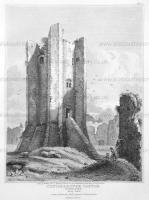Text this colour links to Pages. Text this colour links to Family Trees. Text this colour are links that are disabled for Guests.
Place the mouse over images to see a larger image. Click on paintings to see the painter's Biography Page. Mouse over links for a preview. Move the mouse off the painting or link to close the popup.
All About History Books
The Chronicle of Abbot Ralph of Coggeshall describes the reigns of Kings Henry II, Richard I, John and Henry III, providing a wealth of information about their lives and the events of the time. Ralph's work is detailed, comprehensive and objective. We have augmented Ralph's text with extracts from other contemporary chroniclers to enrich the reader's experience. Available at Amazon in eBook and Paperback.
Conisbrough Castle is in Conisbrough, Castles in South Yorkshire.
After 1066 Conisbrough Castle [Map] was founded by William Warenne 1st Earl of Surrey after he had been awarded estates in Yorkshire, Norfolk and Sussex by King William "Conqueror" I of England (age 38) for his role in the 14th October 1066 Battle of Hastings.
On 24th June 1088 William Warenne 1st Earl of Surrey died at Lewes [Map]. His son William succeeded 2nd Earl Surrey and inherited his estates including Conisbrough Castle [Map].
On 11th May 1138 William Warenne 2nd Earl of Surrey died. His son William (age 19) succeeded 3rd Earl Surrey and inherited his estates including Conisbrough Castle [Map]. Adela Montgomery Countess of Salisbury and Surrey by marriage Countess Surrey.
On 6th January 1148 William Warenne 3rd Earl of Surrey (age 29) died. His daughter Isabella (age 11) succeeded 4th Countess Surrey and inherited his estates including Conisbrough Castle [Map].
In April 1164 Hamelin Warenne Earl of Surrey (age 35) and Isabella Warenne Countess Boulogne 4th Countess of Surrey (age 27) were married by which Conisbrough Castle [Map] came into his posession. He rebuilt the castle in stone. He by marriage Earl Surrey. She the daughter of William Warenne 3rd Earl of Surrey and Adela Montgomery Countess of Salisbury and Surrey. He the illegitmate son of Geoffrey Plantagenet Duke Normandy and Mistress Unknown. They were sixth cousins.
Around 1180 Hamelin Warenne Earl of Surrey (age 51) commissioned the building of a stone castle at Conisbrough [Map]. The castle comprised a Circular Keep with four storeys.





Internal staircase between the first and second floors.


The finely made fireplace on the second floor with decorated capitals.

Window opening on the second floor showing the thickness of the walls of the Keep.


Garderobe on the second floor.

Window opening on the third floor.


Chapel in one of the buttresses on the third floor.

View looking east with the Railway Viaduct over the River Don in the distance.

View of the earthworks of the Outer Bailey.

Entrance to the Keep on the first floor.
![]() Become a Member via our Buy Me a Coffee page to read more.
Become a Member via our Buy Me a Coffee page to read more.
In 1201 King John of England (age 34) visited the new stone-built Conisbrough Castle [Map] whilst it was held by Hamelin Warenne Earl of Surrey (age 72) and Isabella Warenne Countess Boulogne 4th Countess of Surrey (age 64).
On 7th May 1202 Hamelin Warenne Earl of Surrey (age 73) died. His son William succeeded 5th Earl Surrey and inherited his estates including Conisbrough Castle [Map]. He undertook further building work including the Great Hall and service buildings in the Inner Bailey. Maud Marshal Countess Norfolk and Surrey (age 8) by marriage Countess Surrey.
On 27th May 1240 William Warenne 5th Earl of Surrey died. His son John (age 9) succeeded 6th Earl Surrey and inherited his estates including Conisbrough Castle [Map].
On 29th September 1304 John Warenne 6th Earl of Surrey (age 73) died at Kennington, Kent. He was buried at Lewes Priory [Map]. His grandson John (age 18) succeeded 7th Earl Surrey and inherited his estates including Conisbrough Castle [Map].
In 1316 John Warenne 7th Earl of Surrey (age 29) attempted to divorce his wife Joan of Bar Countess of Surrey (age 20). He blamed Thomas Earl of Lancaster (age 38) for his failure to obtain a divorce so kidnapped Thomas' wife Alice de Lacy (age 34) Thomas retaliated by capturing Conisbrough Castle [Map]; King Edward (age 31) confirmed Thomas as the new owner. Thomas subsequenly rebelled against the King and was executed and King Edward took possession of Conisbrough Castle [Map]. Following the usurption of King Edward the castle was returned to John Warenne 7th Earl of Surrey.
In June 1347 John Warenne 7th Earl of Surrey (age 60) died. His nephew Richard (age 41) succeeded 8th Earl Surrey. Eleanor Plantagenet Countess Arundel and Surrey (age 28) by marriage Countess Surrey. Conisbrough Castle [Map] reverted to the Crown.
Around 1374 Constance York Countess Gloucester was born to Edmund of Langley 1st Duke of York (age 32) and Isabella of Castile Duchess York (age 19) at Conisbrough Castle [Map]. She a granddaughter of King Edward III of England. She married before 7th November 1379 her third cousin once removed Thomas Despencer 1st Earl Gloucester, son of Edward Despencer 1st Baron Despencer, Baron Burghesh and Elizabeth Burghesh 3rd Baron Burghesh, and had issue.
On 20th July 1385 Richard of Conisbrough 1st Earl Cambridge was born to Edmund of Langley 1st Duke of York (age 44) and Isabella of Castile Duchess York (age 30) at Conisbrough Castle [Map]. There was speculation the father was John Holland 1st Duke Exeter (age 33) with whom Isabella of Castile Duchess York was suspected of having an affair. Richard received no lands from his father and was not mentioned either in his father's will nor his brother's will. He a grandson of King Edward III of England. He married (1) May 1406 his first cousin twice removed Anne Mortimer, daughter of Roger Mortimer 4th Earl March 3rd Earl of Ulster and Eleanor Holland Countess March and Ulster, and had issue (2) after 21st September 1411 his third cousin twice removed Maud Clifford Countess Cambridge, daughter of Thomas Clifford 6th Baron Clifford and Elizabeth Ros Baroness Clifford.
Before 1402 King Edward III of England gave Conisbrough Castle [Map] to his son Edmund of Langley 1st Duke of York (age 60).
On 1st August 1402 Edmund of Langley 1st Duke of York (age 61) died at King's Langley, Hertfordshire [Map]. His son Edward (age 29) succeeded 2nd Duke York, 2nd Earl Cambridge and inherited his estates which included Conisbrough Castle [Map]. Philippa Mohun Duchess York (age 35) by marriage Duchess York.
On 25th October 1415 King Henry V of England (age 29) defeated a French army at the Battle of Agincourt.
The battle is described by three Chroniclers were present:
Jean de Waurin: "1, the author of this work, know the truth of the matter, for in that assembly I was among the French".
Jean le Fevre de St Remy: "I who write this, seated on a horse among the baggage at the rear of the battle, along with the other priests who were present".
The anonymous author of the Gesta Henrici Quinti i.e. Deeds of Henry V: "while I was on the other side with the English".
Thomas Camoys 1st Baron Camoys (age 64) commanded the Rearguard. Richard de Vere 11th Earl of Oxford (age 30) commanded. Humphrey Lancaster 1st Duke Gloucester (age 25) was wounded, and was protected by his brother King Henry V of England.
Edward 2nd Duke of York 1st Duke Albemarle (age 42), commander of the Vanguard, was killed; the most senior English casualty. Duke Albemarle, Earl of Rutland and Earl Cork extinct. His nephew Richard (age 4) succeeded 3rd Duke York and inherited his estates including Conisbrough Castle [Map].
John Fortescue (age 35), Dafydd Gam Brecon (age 35) and Edward Burnell (age 44) and Roger Vaughan of Bredwardine (age 38) were killed.
Michael de la Pole 3rd Earl Suffolk (age 21) was killed. His brother William (age 19) succeeded 4th Earl Suffolk, 4th Baron Pole.
On 8th April 1435 John "Butcher" Clifford 9th Baron Clifford was born to Thomas Clifford 8th Baron Clifford (age 21) and Joan Dacre Baroness Clifford at Conisbrough Castle [Map]. Coefficient of inbreeding 1.88%. He married 1454 Margaret Bromflete Baroness Clifford, daughter of Henry Bromflete 1st Baron Vesci and Eleanor Fitzhugh Baroness Darcy Knayth and Fitzhugh, and had issue.
Around 1437 Roger Clifford was born to Thomas Clifford 8th Baron Clifford (age 22) and Joan Dacre Baroness Clifford at Conisbrough Castle [Map]. Coefficient of inbreeding 1.88%. He married 1471 his third cousin twice removed Joan Courtenay, daughter of Thomas Courtenay 5th or 13th Earl Devon and Margaret Beaufort Countess Devon, and had issue.
Around 1442 Maud Clifford was born to Thomas Clifford 8th Baron Clifford (age 27) and Joan Dacre Baroness Clifford at Conisbrough Castle [Map]. Coefficient of inbreeding 1.88%. She married (1) before 30th December 1460 her first cousin John Harrington and had issue (2) 1463 her third cousin twice removed Edmund Sutton, son of John Sutton 1st Baron Dudley and Elizabeth Berkeley Baroness Cherleton Baroness Dudley, and had issue.

Conisbrough Castle [Map]. Interior of the Keep Tower. B Howlett, 1814.

Conisbrough Castle [Map]. B Howlett, 1814.
The River Don rises at Dunford Bridge [Map] after which it flows broadly east through Penistone [Map] then south through Oughtibridge [Map], Sheffield [Map] then east through Rotherham [Map], past Conisbrough Castle [Map], Doncaster [Map] and Stainforth [Map] before joining the River Ouse at Goole [Map]. Originally the River Don was a tributary of the River Trent forming the northern boundary of the Isle of Axholme [Map] but was re-engineered by Cornelius Vermuyden as the Dutch River in the 1620s.